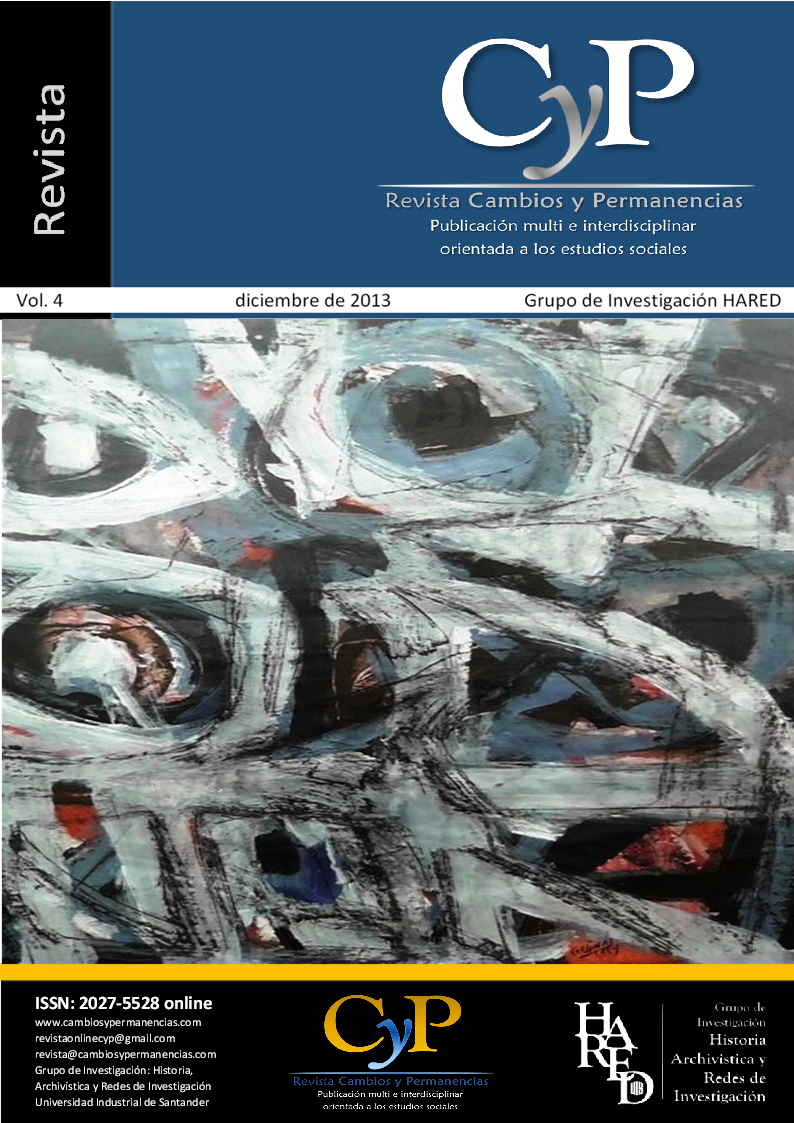Artículos
Published 2013-12-09
Keywords
- Birth,
- trauma,
- pain,
- fear,
- death
- horror film ...More
How to Cite
Cárdenas Arenas, F. D., Trochez Ferreira, D. M., & Díaz Boada, S. A. (2013). Horror film as representation of human existence. Cambios Y Permanencias, (4), 254–275. Retrieved from https://revistas.uis.edu.co/index.php/revistacyp/article/view/7328
Abstract
This is an introductory about the analysis of existence based on Cioran, exemplified in the horror genre films. The mentioned work, entitled "Horror film as representation of human existence" starts with the explanation of the birth as originator of universal human trauma that sentence to human beings to the frustration, being inherent part of life: the pain and the fear. Then, identified three basic concepts, pain, fear and death as innate in existence to relate images that gives the horror films.
Downloads
Download data is not yet available.
References
American Psychological Association. (2013). Trauma. Recuperado de http://www.apa.org/topics/trauma/
Cansino, C. (2005). Cine de terror “Un poco de miedo, de historia y de sueños”. La Trama De La Comunicación, 10, 1-9. Recuperado de http://www.redalyc.org/pdf/3239/323927060030.pdf
Cioran, E. M. (1990). En las cimas de la desesperación. Barcelona: Tusquets Editores.
Cuéllar Barona, M. (s.f.). La figura del monstruo en el cine de horror. Recuperado de http://www.icesi.edu.co/revista_cs/images/stories/revistaCS2/articulos/10-margarita.pdf
Feifell, H. (1963). Psicología existencial. Buenos Aires: Paidós.
Fractman, A. (2005). El concepto de trauma según diferentes autores psicoanalíticos. Recuperado de http://www.apdeba.org/wp-content/uploads/El-concepto-de-trauma.pdf
Freud, S. (1989). El malestar en la cultura (3ra reimp.). México: Alianza.
Gómez Ramírez, M. (s.f.). Muerte y psicología. Recuperado de http://www.politicas.unam.mx/razoncinica/Muerte_y_Psicolog%C3%ADa.html
König, W. H. (2000). El miedo desde la perspectiva de la psicología profunda y la astrología. Recuperado de http://astro-api.es/docs/El_miedo_psicologia_profunda.pdf
León Romero, L. E. (2010). Cine de horror y psicoanálisis. Recuperado de http://wb.ucc.edu.co/pensandopsicologia/files/2010/09/articulo-07-vol1-n1.pdf
Levinas, E. (1994). Dios, la muerte y el tiempo. Madrid: Ediciones Cátedra.
Moscoso, J. (2011). Historia cultural del dolor. Iztapalapa: Santillana Ediciones Generales S.A.
Russek, S. (2007). El dolor y el sufrimiento. Recuperado de http://www.crecimiento-y-bienestar-emocional.com/dolor-emocional.html
Frases al viento. (02 de octubre de 2013). [Mensaje en un blog]. Recuperado de http://www.sabermorir.com/01_sm_pag_sp/smesp_cap/10_frv_esp.html
Sánchez I Sanjuan, J. (2011). Miedo: una mirada filosófica. Recuperado de: http://cafefilomania.com/?p=1139
Schopenhauer, A. (2004). Sobre el dolor del mundo, el suicidio y la voluntad de vivir, Madrid: Tecnos.
Filmografía
Álvarez, F. (2013). Evil Dead (Posesión Infernal) [Cinta cinematográfica]. Estados Unidos: FilmDistrict - Ghost House Pictures - Mandate Pictures - Sony Pictures Entertainment (SPE). De Palma, Brian (1976). Carrie [Cinta cinematográfica]. Estados Unidos: Redbank Films - United Artists.
Goifman, K. (2008). Filmefobia (Filmfobia) [Cinta cinematográfica]. Brasil: Autentika Films.
Knautz, J. (2010). The Shrine (El santuario) [Cinta cinematográfica]. Canadá: Brookstreet Pictures - Wesley Clover Media.
Kubrick, S. (1980). The Shining (El resplandor) [Cinta cinematográfica]. Estados Unidos: Warner Bros. Pictures - Hawk Films - Peregrine.
Wan, J. (2013). The Conjuring (El conjuro) [Cinta cinematográfica]. Estados Unidos: WB - New Line Cinema - Evergreen Media - The Safran Company.
Cansino, C. (2005). Cine de terror “Un poco de miedo, de historia y de sueños”. La Trama De La Comunicación, 10, 1-9. Recuperado de http://www.redalyc.org/pdf/3239/323927060030.pdf
Cioran, E. M. (1990). En las cimas de la desesperación. Barcelona: Tusquets Editores.
Cuéllar Barona, M. (s.f.). La figura del monstruo en el cine de horror. Recuperado de http://www.icesi.edu.co/revista_cs/images/stories/revistaCS2/articulos/10-margarita.pdf
Feifell, H. (1963). Psicología existencial. Buenos Aires: Paidós.
Fractman, A. (2005). El concepto de trauma según diferentes autores psicoanalíticos. Recuperado de http://www.apdeba.org/wp-content/uploads/El-concepto-de-trauma.pdf
Freud, S. (1989). El malestar en la cultura (3ra reimp.). México: Alianza.
Gómez Ramírez, M. (s.f.). Muerte y psicología. Recuperado de http://www.politicas.unam.mx/razoncinica/Muerte_y_Psicolog%C3%ADa.html
König, W. H. (2000). El miedo desde la perspectiva de la psicología profunda y la astrología. Recuperado de http://astro-api.es/docs/El_miedo_psicologia_profunda.pdf
León Romero, L. E. (2010). Cine de horror y psicoanálisis. Recuperado de http://wb.ucc.edu.co/pensandopsicologia/files/2010/09/articulo-07-vol1-n1.pdf
Levinas, E. (1994). Dios, la muerte y el tiempo. Madrid: Ediciones Cátedra.
Moscoso, J. (2011). Historia cultural del dolor. Iztapalapa: Santillana Ediciones Generales S.A.
Russek, S. (2007). El dolor y el sufrimiento. Recuperado de http://www.crecimiento-y-bienestar-emocional.com/dolor-emocional.html
Frases al viento. (02 de octubre de 2013). [Mensaje en un blog]. Recuperado de http://www.sabermorir.com/01_sm_pag_sp/smesp_cap/10_frv_esp.html
Sánchez I Sanjuan, J. (2011). Miedo: una mirada filosófica. Recuperado de: http://cafefilomania.com/?p=1139
Schopenhauer, A. (2004). Sobre el dolor del mundo, el suicidio y la voluntad de vivir, Madrid: Tecnos.
Filmografía
Álvarez, F. (2013). Evil Dead (Posesión Infernal) [Cinta cinematográfica]. Estados Unidos: FilmDistrict - Ghost House Pictures - Mandate Pictures - Sony Pictures Entertainment (SPE). De Palma, Brian (1976). Carrie [Cinta cinematográfica]. Estados Unidos: Redbank Films - United Artists.
Goifman, K. (2008). Filmefobia (Filmfobia) [Cinta cinematográfica]. Brasil: Autentika Films.
Knautz, J. (2010). The Shrine (El santuario) [Cinta cinematográfica]. Canadá: Brookstreet Pictures - Wesley Clover Media.
Kubrick, S. (1980). The Shining (El resplandor) [Cinta cinematográfica]. Estados Unidos: Warner Bros. Pictures - Hawk Films - Peregrine.
Wan, J. (2013). The Conjuring (El conjuro) [Cinta cinematográfica]. Estados Unidos: WB - New Line Cinema - Evergreen Media - The Safran Company.

